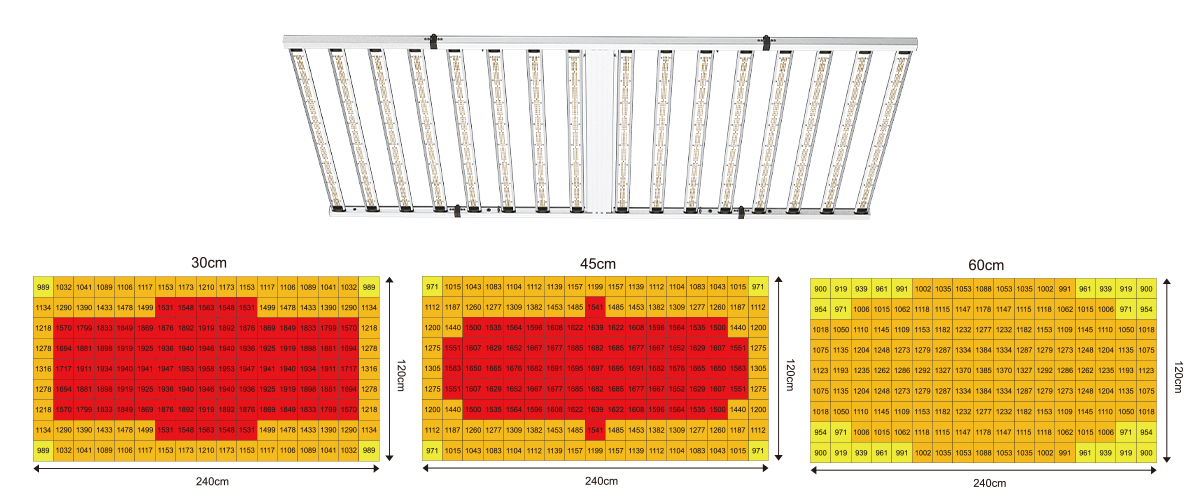If you think that plant care is just about occasional watering and fertilizing, you might be overlooking a crucial factor: lighting. For indoor plants, insufficient light is like never being full, no matter how much they grow, they won't thrive.
Speaking of lighting, it’s essential to mention PPFD.
What is PPFD?
PPFD—Photosynthetic Photon Flux Density—might sound technical, but it’s simple to understand. PPFD measures the number of photons hitting a square meter of plant foliage per second. This metric tells you whether your plants are enjoying enough sunlight.

Is it really necessary to be so precise? Absolutely. Whether it’s succulents or your indoor herb garden, each plant has specific lighting needs. Insufficient light can make plants look weak, grow slowly, and even affect flowering and fruiting. Just as people need the right amount of food and water, plants need the right amount of light—not too much, nor too little.
PPFD Requirements for Different Plants
Knowing the PPFD requirements of each plant is key to accurately adjusting indoor lighting. Plants' PPFD needs can generally be categorized into three types: low-light, medium-light, and high-light plants. This classification helps us choose the right lighting intensity based on the type and growth stage of the plants.

Low-light plants: These plants thrive in relatively low light conditions. Generally, a PPFD of 100-200 µmol/m²/s is sufficient. Common low-light plants include ferns, ivy, and some foliage plants like the dragon tree. These plants often grow under the shade of trees in their natural habitat, so they are adapted to lower light intensities.
Medium-light plants: Require slightly higher PPFD values, generally between 200-500 µmol/m²/s. This category includes many indoor decorative plants, like African violets and some types of cacti. They need more light than low-light plants but cannot withstand direct sunlight.
High-light plants: These plants need the highest PPFD values, typically between 500-1000 µmol/m²/s or more. This includes most fruit and vegetable plants, such as tomatoes, peppers, and most herbs. These plants require a lot of light during their growth phases to support rapid growth and fruiting.
PPFD Requirements for Cannabis Plants: Cannabis plants, increasingly popular for medical and recreational use, have particularly unique lighting needs.
In the germination and seedling stages, a recommended PPFD value is between 200-400 µmol/m²/s.
As the plant enters the vegetative phase, the PPFD should increase to 400-600 µmol/m²/s.
During the flowering phase, the PPFD needs of cannabis plants further increase, typically requiring 800-1500 µmol/m²/s to ensure ample energy for producing abundant flowers and resin.
For indoor growers, understanding which category your plants fall into and their lighting needs at different growth stages is essential for ensuring their healthy growth. The right PPFD not only promotes plant growth but also helps prevent plant diseases and encourages better flowering and fruiting.
Common Questions About PPFD
Do different plants have the same PPFD requirements?
No, different plants have varying PPFD needs based on their natural habitats, genetic traits, and growth stages.
For example, plants native to the understory of tropical rainforests, like certain orchids and ferns, are adapted to low-light environments and therefore have lower PPFD needs.
In contrast, plants native to open areas like deserts, such as cacti and some succulents, are adapted to high-light environments and thus require higher PPFD levels. Additionally, even the same species of plant may have different PPFD needs during different life stages (e.g., growth phase, flowering phase).
What happens if PPFD is too high?
Excessively high PPFD can lead to several adverse effects, including leaf burn, chlorophyll degradation, and reduced photosynthesis efficiency.
High light intensity increases the surface temperature of leaves, causing rapid evaporation of water and exposing plants to both thermal and light stress.
This prolonged condition can lead to photoinhibition, where the overall efficiency of photosynthesis declines due to excessive light intensity. Additionally, too high PPFD can disrupt normal plant metabolism, leading to stunted growth.
What if PPFD is too low?
Too low PPFD can cause plants to grow slowly, hinder chlorophyll synthesis, and affect their photosynthesis and energy production.
Plants in too low PPFD conditions may exhibit etiolation, where they abnormally elongate in search of light, leading to a fragile structure. Long-term insufficient lighting can also lead to reduced flowering, poor fruit development, or decreased yields.
How to adjust PPFD?
Adjusting PPFD typically involves changing the distance between the light source and the plants, selecting the appropriate light intensity, adjusting the duration of lighting, or using reflective materials to improve light distribution. For instance, raising or lowering light fixtures can change。
PPFD to suit specific plant needs. Additionally, using timers to control lighting duration can help simulate the natural day-night cycle, thereby adjusting light intensity. For environments that require precise control, like greenhouses or indoor cultivation, using adjustable intensity LED grow lights can provide more accurate PPFD control, optimizing plant growth conditions.
VANQ has 20 years of professional experience in the field of LED grow lights and has successfully served more than 3,000 customers. Click the dialog box below to contact us now. We will provide you with personalized planting solutions based on your planting needs. The first 30 people will receive a 10% discount coupon.























